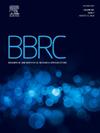Evaluation of the role of hepatic Gstm4 in diet-induced obesity and dyslipidemia
IF 2.5
3区 生物学
Q3 BIOCHEMISTRY & MOLECULAR BIOLOGY
Biochemical and biophysical research communications
Pub Date : 2024-10-28
DOI:10.1016/j.bbrc.2024.150920
引用次数: 0
Abstract
Obesity and its related diseases continue to rise worldwide, necessitating further investigation to develop new therapeutic strategies. The dysregulation of redox homeostasis is tightly associated with metabolic diseases. Glutathione, an antioxidant, acts as a cofactor for antioxidant and detoxification enzymes such as glutathione S-transferases (GSTs)—a superfamily including Gstm4. So far, the physiological role of Gstm4 remains largely unknown. Human genetics is a powerful tool to discover novel therapeutic targets for metabolic diseases. The single nucleotide polymorphism rs650985, located within the sixth intron of the human gene Gstm4, was associated with plasma lipids, indicating that targeting Gstm4 might intervene in the progression of dyslipidemia. Furthermore, we found that Gstm4 is highly expressed in the liver and enriched in hepatocytes—the parenchymal cells of the liver. We established the mouse model with the hepatic deletion of Gstm4 and found that this mouse model did not present altered body weight, serum lipid profile, or liver fat content in the context of chow or high-fat high cholesterol diet feeding, indicating that hepatic Gstm4 is dispensable for diet-induced obesity and dyslipidemia. Further analysis revealed that hepatic deletion of Gstm4 upregulates the level of protein but not mRNA of Npc1l1—a critical protein mediating cholesterol uptake, suggesting that there might be a link between Gstm4 and lipid metabolic diseases in certain contexts.
评估肝脏 Gstm4 在饮食诱发肥胖和血脂异常中的作用
肥胖症及其相关疾病在全球范围内持续上升,因此有必要进行进一步研究,以开发新的治疗策略。氧化还原平衡失调与代谢性疾病密切相关。谷胱甘肽是一种抗氧化剂,是谷胱甘肽 S-转移酶(GSTs)等抗氧化和解毒酶的辅助因子,其中包括 Gstm4 这个超家族。迄今为止,Gstm4 的生理作用在很大程度上仍不为人所知。人类遗传学是发现代谢性疾病新治疗靶点的有力工具。位于人类基因 Gstm4 第六个内含子的单核苷酸多态性 rs650985 与血浆脂质有关,这表明靶向 Gstm4 可能会干预血脂异常的进展。此外,我们还发现 Gstm4 在肝脏中高度表达,并富集在肝细胞--肝脏的实质细胞中。我们建立了肝脏缺失 Gstm4 的小鼠模型,发现该小鼠模型在进食低脂或高脂高胆固醇饮食的情况下,体重、血清脂质谱和肝脏脂肪含量均无改变,表明肝脏 Gstm4 在饮食诱导的肥胖和血脂异常中是不可或缺的。进一步的分析表明,肝脏缺失Gstm4会上调Npc1l1--一种介导胆固醇摄取的关键蛋白--的蛋白水平,但不会上调其mRNA水平,这表明在某些情况下,Gstm4与脂质代谢疾病之间可能存在联系。
本文章由计算机程序翻译,如有差异,请以英文原文为准。
求助全文
约1分钟内获得全文
求助全文
来源期刊
CiteScore
6.10
自引率
0.00%
发文量
1400
审稿时长
14 days
期刊介绍:
Biochemical and Biophysical Research Communications is the premier international journal devoted to the very rapid dissemination of timely and significant experimental results in diverse fields of biological research. The development of the "Breakthroughs and Views" section brings the minireview format to the journal, and issues often contain collections of special interest manuscripts. BBRC is published weekly (52 issues/year).Research Areas now include: Biochemistry; biophysics; cell biology; developmental biology; immunology
; molecular biology; neurobiology; plant biology and proteomics

 求助内容:
求助内容: 应助结果提醒方式:
应助结果提醒方式:


